Related Research Articles
(444004) 2004 AS1, provisional designation 2004 AS1, and also known by the temporary name AL00667, is a sub-kilometer asteroid, classified as near-Earth object and potentially hazardous asteroid of the Apollo group, approximately 300 meters in diameter.

66391 Moshup, provisional designation 1999 KW4, is a binary asteroid, classified as a near-Earth object and potentially hazardous asteroid of the Aten group, approximately 1.3 kilometers in diameter. It was discovered on 20 May 1999, by Lincoln Near-Earth Asteroid Research (LINEAR) at the Lincoln Laboratory's Experimental Test Site in Socorro, New Mexico, United States. It is a Mercury-crosser that comes extremely close to the Sun at a perihelion of 0.2 AU.

1221 Amor is an asteroid and near-Earth object on an eccentric orbit, approximately 1 kilometer (0.6 miles) in diameter. It is the namesake of the Amor asteroids, the second-largest subgroup of near-Earth objects. It was discovered by Eugène Delporte at the Uccle Observatory in 1932, the first time that an asteroid was seen to approach Earth so closely. The assumed S-type asteroid is one of few low-numbered asteroids for which no rotation period has been determined. It was assigned the provisional designation 1932 EA1 and named for Cupid, also known as "Amor" in Latin, the Roman equivalent of the Greek god Eros.
(68950) 2002 QF15 is a stony asteroid, classified as near-Earth object and potentially hazardous asteroid of the Apollo group, that measures approximately 2 kilometers in diameter. It was discovered on 27 August 2002, by the LINEAR project at Lincoln Laboratory's Experimental Test Site in Socorro, New Mexico, United States.
(179806) 2002 TD66 (also written 2002 TD66) is a sub-kilometer asteroid, classified as near-Earth object of the Apollo group. It was discovered on 5 October 2002, by the LINEAR project at Lincoln Laboratory's ETS in Socorro, New Mexico. It was announced on 7 October 2002 and appeared later that day on the JPL current risk page.
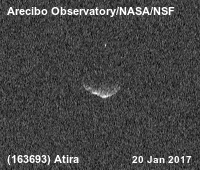
163693 Atira (; provisional designation 2003 CP20) is a stony asteroid, dwelling in the interior of Earth's orbit. It is classified as a near-Earth object. Atira is a binary asteroid, a system of two asteroids orbiting their common barycenter. The primary component with a diameter of approximately 4.8 kilometers (3 miles) is orbited by a minor-planet moon that measures about 1 km (0.6 mi). Atira was discovered on 11 February 2003, by astronomers with the Lincoln Near-Earth Asteroid Research at Lincoln Laboratory's Experimental Test Site near Socorro, New Mexico, in the United States.
(237442) 1999 TA10, provisionally known as 1999 TA10, is a near-Earth object (NEO) from the Amor asteroid group. It is suspected of being an inner fragment of the differentiated asteroid 4 Vesta.
(612358) 2002 JE9 (also written 2002 JE9) is an Apollo near-Earth asteroid and potentially hazardous object. It has a well determined orbit with an observation arc of 10 years and an Uncertainty Parameter of 1. It was removed from the Sentry Risk Table on 10 May 2002. 2002 JE9 was discovered on 6 May 2002 by the Lincoln Near-Earth Asteroid Research (LINEAR) project using a 1.0-metre (39 in) Reflecting telescope; at the time of discovery, the asteroid possessed an apparent magnitude of 19.1.
(152680) 1998 KJ9 is a sub-kilometer asteroid, classified as near-Earth object and potentially hazardous asteroid of the Apollo group. Based on absolute magnitude, it is the third largest asteroid known to have passed closer than the Moon.
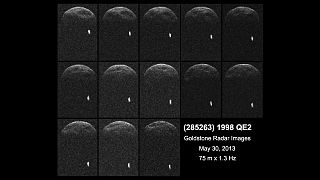
(285263) 1998 QE2, provisional designation 1998 QE2, is a dark asteroid and synchronous binary system, classified as near-Earth object and potentially hazardous asteroid of the Amor group, approximately 3 kilometers in diameter. It was discovered on 19 August 1998, by astronomers of the LINEAR program at Lincoln Laboratory's Experimental Test Site near Socorro, New Mexico, in the United States. Its sub-kilometer minor-planet moon was discovered by radar on 30 May 2013.
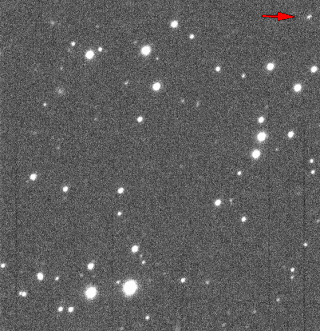
(511002) 2013 MZ5, provisional designation 2013 MZ5, is a sub-kilometer asteroid, classified as a near-Earth object of the Amor group, estimated to measure approximately 300 meters (1,000 feet) in diameter. It was discovered on 18 June 2013, by astronomers with the Pan-STARRS survey at Haleakala Observatory on the island of Maui, Hawaii, in the United States. It was the 10,000th near-Earth object ever discovered.
(86039) 1999 NC43 (provisional designation 1999 NC43) is an asteroid on an eccentric orbit, classified as near-Earth object and potentially hazardous asteroid of the Apollo group, approximately 2 kilometers in diameter. This suspected tumbler and relatively slow rotator was discovered by LINEAR in 1999.
(374158) 2004 UL is a sub-kilometer asteroid on an outstandingly eccentric orbit, classified as near-Earth object and potentially hazardous asteroid of the Apollo group. The object is known for having the second-smallest perihelion of any known asteroid, after (137924) 2000 BD19.
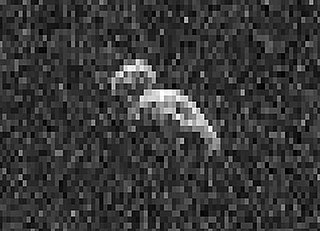
(388188) 2006 DP14, provisional designation 2006 DP14, is a sub-kilometer sized, peanut-shaped asteroid on a highly eccentric orbit, classified as near-Earth object and potentially hazardous asteroid of the Apollo group. This contact binary was discovered on 23 February 2006, by astronomers of the LINEAR program at the Lincoln Laboratory's Experimental Test Site near Socorro, New Mexico, in the United States. On 10 February 2014, it passed 6.25 lunar distances from Earth. The asteroid is approximately 400 meters in diameter and has a rotation period of 5.77 hours.

(523972) 1999 CW8, provisional designation 1999 CW8, is a bright carbonaceous asteroid and sub-kilometer near-Earth object of the Apollo group, first observed on 12 February 1999, by astronomers of the Lincoln Near Earth Asteroid Research program at Lincoln Laboratory ETS in New Mexico, United States.
2001 AV43 is a very small, monolithic asteroid and fast rotator, classified as a near-Earth object of the Apollo group, approximately 30 meters (98 feet) in diameter. It was first observed on 5 January 2001, by astronomers of the LINEAR program at Lincoln Laboratory's Experimental Test Site near Socorro, New Mexico, in the United States. The presumed S-type asteroid has a rotation period of only 10 minutes. It has an exceptionally low MOID of 0.66 lunar distance (LD) and will approach Earth at 0.81 LD on 11 November 2029.

2017 OO1 is a small asteroid, classified as near-Earth object of the Aten group, approximately 35–76 meters (115–249 feet) in diameter. It was first observed on 23 July 2017, by the robotic ATLAS survey at Mauna Loa Observatory, Hawaii, two days after the object had approached Earth at 0.33 lunar distances on 21 July 2017.
(89830) 2002 CE, is a stony asteroid, classified as near-Earth object and potentially hazardous asteroid of the Amor group, approximately 3.1 kilometers in diameter. It was discovered on 1 February 2002, by astronomers of the LINEAR program at Lincoln Laboratory's Experimental Test Site near Socorro, New Mexico, in the United States. This asteroid is one of the largest potentially hazardous asteroid known to exist.

(85990) 1999 JV6 (provisional designation 1999 JV6) is a sub-kilometer near-Earth asteroid and a potentially hazardous object of the Apollo group. It was discovered by astronomers of the LINEAR program at the Lincoln Laboratory's Experimental Test Site near Socorro, New Mexico. 1999 JV6 is a contact binary object consisting of two distinct lobes, as seen in radar images from various observatories including Arecibo and Goldstone in January 2015.
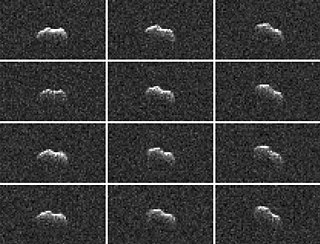
(231937) 2001 FO32 is a near-Earth asteroid classified as a potentially hazardous asteroid of the Apollo group. With an estimated diameter around 550 m (1,800 ft), it was discovered by the Lincoln Near-Earth Asteroid Research at Socorro, New Mexico on 23 March 2001. The asteroid safely passed by Earth on 21 March 2021 16:03 UTC from a closest approach distance of 0.0135 AU (2.02 million km; 1.25 million mi), or 5.25 lunar distances (LD). During the day before closest approach, 2001 FO32 reached a peak apparent magnitude of 11.7 and was visible to ground-based observers with telescope apertures of at least 20 cm (8 in). It is the largest and one of the fastest asteroids to approach Earth within 10 LD (3.8 million km; 2.4 million mi) in 2021.
References
- 1 2 3 4 5 "2003 SM84". Minor Planet Center. Retrieved 20 December 2019.
- 1 2 3 4 5 "JPL Small-Body Database Browser: (2003 SM84)" (2015-12-05 last obs.). Jet Propulsion Laboratory. Archived from the original on 2 September 2020. Retrieved 20 December 2019.
- 1 2 3 "Asteroid Size Estimator". CNEOS NASA/JPL. Retrieved 20 December 2019.
- ↑ Nerlich, Steve (13 August 2011). "Astronomy Without A Telescope – Impact Mitigation". www.universetoday. Retrieved 20 December 2019.